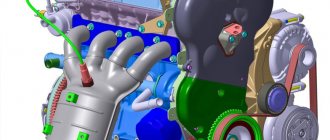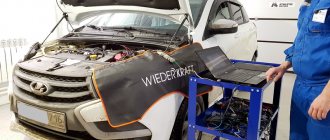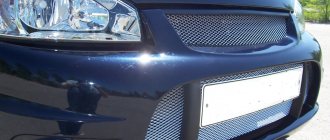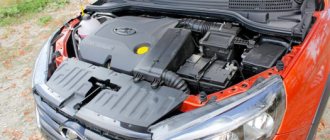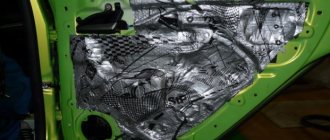Not much time has passed since the start of sales of new products from the domestic automobile industry, but tuning enthusiasts have already begun to work on improving the car. Tuning Lada Vesta SV Cross is a series of activities aimed at improving the car. Namely, external styling, which affects the exterior of the car. For example, installing non-standard body kits or new rims. In fact, external tuning of the Lada Vesta SV Cross is most often aimed at improving the appearance. Such tuning has virtually no effect on speed characteristics. However, for deep customization of the car, external styling can also contribute. For example, a properly selected body kit improves not only the appearance, but also has a positive effect on aerodynamic characteristics. And lightweight rims affect the handling and acceleration of the car. Therefore, external tuning of a car does not always make changes only to the appearance.
In addition to the usual tuning of the exterior, you can also work on the interior. For example, a regular interior re-upholstery will not affect performance in any way. In general, in the interior of the Lada Vesta SV Cross there is a whole expanse for tuning. For most people, tuning means installing a powerful audio system or soundproofing a car. For people involved in motorsports, tuning the interior is to make it as light and strong as possible. Often all plastic, seats, and panels are completely thrown out of the interior. Instead of the driver's seat, a sports bucket is installed, and instead of the instrument panel, special sensors are installed. To prevent deformation of the body during an accident, a special safety cage is installed in the cabin - bolted or welded.
Chip tuning of the Lada Vesta Cross engine
The most common option to improve the Lada Vesta engine without spending a large amount of money is chip tuning.
Chipping is the re-flashing of an electronic unit with the subsequent installation of software devices with new parameters. The positive side of this modernization is that there is no need to disrupt the design of the motor.
How chip tuning improves ride quality:
- If before the improvement the car was not driving fast and changed gears for a long time, then after flashing the gear shift speed and dynamics noticeably increase;
- fuel consumption can be significantly reduced;
- Risks when overtaking on the highway are reduced;
- If before tuning, errors on the dashboard could appear due to low-quality fuel, now they appear only in case of significant malfunctions;
- The power increase can be up to 15%.
Thus, chipping reveals the full potential of the Lada Vesta Cross internal combustion engine.
Negative points that you should familiarize yourself with before deciding to upgrade Vesta SW Cross:
- The cost of the offer can vary from two to fifteen thousand rubles. But it’s better not to agree to cheap offers; most likely, you won’t get a good result;
- After tuning, official dealers refuse to carry out repairs under warranty;
- The engine life is reduced by an average of five percent. This is not a very serious indicator, but in the future it can have a negative impact on the operation of the AMT.
A less common modernization option involves replacing engine parts - cylinders, shafts, and so on. The cost varies from fifty to one hundred thousand. Due to the cost and complexity, this option is rare.
Tuning the Vesta Cross engine allows you to increase power and use fuel economically. However, if the car has a warranty, it is better not to carry out such manipulations, and in the event of a poor-quality transformation of the engine, repairs will need to be carried out at the expense of the owner, and not the company.
Review from the owner of Vesta SV Cross about chip tuning 1.8 for manual transmission
But if everything is done efficiently and in a good car workshop, the Lada Vesta Cross will significantly improve its technical parameters.
How many liters is the trunk of the Vesta?
Among domestic car enthusiasts you can often meet gardeners, summer residents, fishermen, tourists, builders, installers and other lovers of large trunks in cars.
It’s not for nothing that the well-known “four” held a high rating among VAZ cars for so long - low cost and excellent capabilities for transporting various cargoes.
And if you want to choose a car for yourself that will give you the opportunity to transport various weights, then you will have to try hard, because the volume of the trunk is far from the most important thing
It is equally important to take into account a number of other points:
- width, length and height
- dimension of the opening for loading with the trunk lid open
- ability to fold rear passenger seats
- luggage compartment bottom edge height
- trunk lining material
Lada Vesta SW Cross
They've been waiting for what they promised for two years. Launching serial production of the Lada Vesta sedan on September 25, 2015, the then head of AVTOVAZ, Bo Andersson, promised that the station wagon would hit the production line exactly a year later - September 25, 2016. But even less than a year passed... and Andersson left, and bold commitments had to be reconsidered.
Serial production should begin in July. If there are no failures, this year a total of about nine thousand cars will be made - approximately equal parts of both modifications. They will go on sale in the fall.
The domestic novelty Lada Vesta SV station wagon is gradually gaining popularity in the domestic market.{amp}lt;p{amp}gt;
The car in the 2022 version is distinguished by a large number of options that were not previously used on Russian production cars.
Before purchasing, many car enthusiasts are interested in the technical characteristics of the SV
Most often, buyers pay direct attention to trunk volume and engine type.
HomeVAZ 2110 How many liters does the Vesta have in the trunk?
When choosing a new car, the trunk is usually the last thing people look at. But there are still those for whom both the volume and layout of the luggage compartment are important, especially if the car is planned to be used for frequent transportation of oversized cargo, for example, along the city-dacha route.
Vesta in this regard is positioned as a universal car offering a spacious trunk. X Ray is much more modest, but even he is not too lost compared to his competitors.
By the way, today we will compare with Solaris, Rio, Logan, Rapid, Datsun-On-Do, adding the Vesta Cross station wagon for completeness.
Trunk of Skoda Rapid
External tuning (styling) of Vesta SV Cross
First of all, a car is evaluated externally, so exterior styling plays no less important role than the engine and interior.
Photo of one of the tuning options according to the portal “kolesa.ru”:
How you can carry out external tuning and at the same time make your car more attractive and practical:
- Installation of a special element to improve the aerodynamic performance of the body (spoiler). This element visually makes the Lada Vesta more dynamic in appearance, while preventing dirt from getting on license plates and increasing downforce. The cost is approximately two and a half thousand rubles;
- Installation of flexible shields made of plastic or a mixture of rubber and plastic (mud flaps). Protects the body and vehicles behind from splashes. The average price is one thousand rubles for one set, may vary depending on the material;
- Using a chrome-plated stainless steel grill that is placed on top of the existing one. Its main function is to protect the radiator from small debris and stones. The average cost is five thousand rubles;
- Body painting is more of a decorative element and has no practical application, but is quite popular. Such tuning will give the Vesta Cross version uniqueness and emphasize the taste and preferences of its owner;
- Installing new disks. The engine power allows the installation of seventeen- and eighteen-inch wheels, the downside is the increase in fuel consumption. But it is possible to choose any design, which will also emphasize individuality;
- Installation of deflectors, so-called visors, protecting the interior from dirt and moisture when driving;
- The arch extension is a very practical accessory that prevents the appearance of dirt and splashes on the sides of the car;
- The door sill trim as a tuning option for Vesta Cross helps protect them from abrasions, which are not cheap to restore. In addition, defects in the thresholds can subsequently cause rust, which will not please the owner. This accessory has many varieties - it can be made of chrome, plastic, fiberglass. They can be backlit or not;
- Covers on the door, mirrors, and gas tank hatch also have a place and perform not only a decorative function, but also protect from chips those vulnerable parts of the body that are most susceptible to this.
In general, the car looks quite beautiful and stylish even without tuning. But it never hurts to make improvements that not only create a more expensive look, but are also functional.
Video about external tuning (what Vesta Cross could look like)
Conclusion
Vesta - since its appearance, it has become the object of desire of many Russian drivers. But everything turned out to be not as smooth as the manufacturer promised. Many problems have been fixed, but some will have to be dealt with on their own. Thanks to tuning, you can “tailor” the car to suit you. Yes, it takes time and money. In addition, some modifications may lead to loss of warranty and reliability of the machine. But on the other hand, you will get a more comfortable Vesta with greater capabilities. Therefore, whether to do tuning or not is your purely personal decision. Although sometimes this is more a necessity than a desire to show off.
Source
Interior tuning
Despite the fact that the interior of the Vesta SW Cross is made with high quality and accuracy, there is potential for tuning.
What can be improved:
- The standard armrest can be trimmed with leather instead of fabric. This will make it look more expensive and be less susceptible to abrasion. The approximate price of such an improvement is four thousand rubles;
- Depending on the quality, interior carpets can completely follow all curves and do not require additional fastening. The floor is reliably protected from moisture, dust, and dirt from the street. The cost is about two thousand and above;
- The trunk mat protects against scratches, spilled liquids and other unpleasant situations;
- Seat covers can be chosen according to your taste and from any material;
- Modernization of the cabin filter;
- All kinds of overlays for the front panel.
Handling and off-road performance
Introducing the new model, the manufacturer positioned the 2022 Lada Vesta Cross as a car in the class of compact off-road vehicles. Improved off-road performance is influenced by increased ground clearance, thanks to which the car can quite easily overcome various obstacles both in a metropolis and when driving off-road. Owners of cars with a CVT should not forget that this type of transmission does not tolerate extreme loads quite well and is prone to overheating. Therefore, for fans of off-road drifting, the best option would be a model with a manual transmission.
On high-quality asphalt surfaces, the car behaves confidently, easily negotiating both flat areas and turns. When driving on poor-quality roads, rear passengers may feel discomfort from the resulting bumpiness. In general, if the suspension is maintained in good technical condition, this model can provide driving pleasure and demonstrate high driving performance.
Music
Acoustics
Next we move on to the main topic. New acoustics were installed in the front and rear doors:
- Front doors – Hertz ESK 165.5L – component 2-way with connection via a standard crossover – price 8820 rubles;
- Rear doors – Hertz ESX 165.5 – coaxial – 5350 rubles.
- Trunk - 10-inch Audio System R10 subwoofer, covered with mesh - cost 6,400 rubles.
The speakers were installed in specially made podiums.
The subwoofer speaker is on the left side, while the amplifier is mounted on the right side.
Radio tape recorder
As for the radio, for tuning the Lada Vesta SW Cross, the LOUD SOUND studio chose the Pioneer 5000 head unit.
This complex is equipped with a new generation monitor with improved color reproduction. There is also an upgraded signal processor (sound processor). This ensures that you have the widest range of options for customizing your sound, from time delays to crossovers. Naturally, the head unit supports almost all formats, it is easy to change themes, etc. A rear view camera is also connected to the system, the image from which is shown on the monitor.
Among the problems, it is necessary to note the lack of adapters, in particular, for the rear view camera, which is why the trajectory marks do not work (they are simply static and do not respond to steering wheel turns). In addition, for the same reason, it was not possible to connect the radio to the multifunction steering wheel - the volume keys and the speakerphone.
In addition to the improvements listed above, there are others:
- A full range of work on vibration and noise insulation of the interior was carried out;
- More powerful signals have been installed;
- The machine is equipped with gas hood stops.
You can see the full review in the video.
Review of a set of improvements for Lada Vesta SW Cross (super exclusive tuning)
One of the owners of the Lada Vesta SW Cross (1.8 liter with manual transmission in the Luxe configuration) decided to comprehensively modify his car. The main changes affected the interior and trunk of the station wagon. The author talks about what happened in the end in the video review “Lada Vesta SW CROSS super exclusive tuning”.
- Android radio with Internet connection (via WI-FI via SIM card), see review of 2DIN radios.
- Engine start/stop button (how to install).
- Alarm control via phone (open/close, start the engine, position on the map).
- Floor lighting for the driver and front and rear passengers (how to install).
- Lighting in door handles (how to do it).
- Illumination in a tunnel niche (how to do it).
- USB socket in the central tunnel for rear passengers (how to install).
- Threshold covers (buy).
- Improved fixation of door stops (how to do it).
- Plugs for door stops (see these and other accessories from AliExpress).
- The DVR is hidden behind the mirror and connected to the radio (how to connect).
- Amplifier for front speakers (installed under the dashboard).
- HBO (cylinder instead of a spare tire).
- Trunk light from Renault Duster and LED lamps.
- Silicone trunk mat.
- Subwoofer (quick-release) and amplifier under the trunk trim.
- Alternative rear view camera with recording function (how to connect).
Another accessory discussed in the review is snow chains.
How do you rate this tuning of the Lada Vesta SW Cross?
Not much time has passed since the start of sales of new products from the domestic automobile industry, but tuning enthusiasts have already begun to work on improving the car. Tuning Lada Vesta SV Cross is a series of activities aimed at improving the car. Namely, external styling, which affects the exterior of the car. For example, installing non-standard body kits or new rims. In fact, external tuning of the Lada Vesta SV Cross is most often aimed at improving the appearance. Such tuning has virtually no effect on speed characteristics. However, for deep customization of the car, external styling can also contribute. For example, a properly selected body kit improves not only the appearance, but also has a positive effect on aerodynamic characteristics. And lightweight rims affect the handling and acceleration of the car. Therefore, external tuning of a car does not always make changes only to the appearance.
In addition to the usual tuning of the exterior, you can also work on the interior. For example, a regular interior re-upholstery will not affect performance in any way. In general, in the interior of the Lada Vesta SV Cross there is a whole expanse for tuning. For most people, tuning means installing a powerful audio system or soundproofing a car. For people involved in motorsports, tuning the interior is to make it as light and strong as possible. Often all plastic, seats, and panels are completely thrown out of the interior. Instead of the driver's seat, a sports bucket is installed, and instead of the instrument panel, special sensors are installed. To prevent deformation of the body during an accident, a special safety cage is installed in the cabin - bolted or welded.
The worse the better
. When I saw the canister flying towards me, I shuddered. Apparently, she fell out of some passing truck and was now sliding with a roar along the asphalt, right under the bumper of my car. The speed was too high for a sharp maneuver, and all I could do was try to pass the obstacle between the wheels. I have already come to terms with the fact that now I will have to pull over to the side of the road, sadly inspect the damage to the bumper, or even somehow dig out this most ill-fated canister from under the bottom of the car. But, strangely enough, there was no blow. Glancing in the rearview mirror, I was convinced that the canister was rapidly moving away, continuing to slide along the road. It seems that she did not even change the trajectory of her movement.
Are you lucky? No, in fact, it was quite natural - the ground clearance of the new Lada Vesta Cross is more than 20 cm. Or 203 mm, to be extremely precise. The ground clearance here, by the way, is even greater than that of the average modern crossover. In order to achieve this, Togliatti engineers did not have to resort to the inappropriate use of tennis balls and other “collective farm” rubbish, which we so love to use when we need to quickly and inexpensively shoe another flea. Everything was done competently and scientifically. The new suspension is 25 mm higher than that of the “simple” Lada Vesta sedan, and at the same time it works even better! At least in my opinion.
We have already seen almost the same suspension on the Vesta SW Cross model. But, unlike the station wagon, which has reinforced rear springs designed for increased loads, here they were done without them. The front springs and all shock absorbers are the same for both the sedan and the station wagon. They also have absolutely identical “protective” body kits. It looks great, but in reality, it doesn’t protect anyone from anything. Well, perhaps from small stones flying from under the wheels of other cars. And even then, it’s unlikely.
I will not describe here the wheel arch extensions, door sills and decorative trim on the bumpers - all these details are clearly visible in our photographs. Let's get back to how the suspension works. She really surprises. The energy intensity is so high that it is simply impossible to “short-circuit” the springs and shock absorbers before they break through to the body. Speed bumps of various sizes can be overcome without a shadow of a doubt. After a few kilometers of driving Vesta Cross, you involuntarily catch yourself starting to choose not the smoothest road, but, on the contrary, the most broken one. Potholes in the asphalt, protruding sewer manholes, ruts crushed by trucks - this is what we need. The car jumps over them with the enthusiasm of a rubber ball. Bumpy dirt road? Wonderful! Here we go. The old rally principle of “more travel, less holes” works one hundred percent in this case.
SEAT Ibiza FR (3-door hatchback)
The car has a fairly deep track that is not a hindrance to which almost most crossovers will fail. The clearance allows you to fearlessly dive into it and easily jump back out. The only thing that can cool down the ardor of those who like to storm off-road are pure Pirelli road tires, which are powerless against liquid, soggy mud. And, of course, there is no locking and all-wheel drive. The suspension travel here is not so large that there is no fear of diagonal hanging. And if suddenly such a nuisance happens, you can only continue to push or pull. By tractor!
Brake tuning Lada Vesta SV Cross
It is not enough just to accelerate the car, it is also important to stop it. To do this, experts recommend tuning the brakes of the Lada Vesta SV Cross.
The most common changes are larger brake discs, which can be ventilated and perforated, as well as stiffer brake pads. Even replacing standard brake discs with larger ones can significantly improve the braking system. If there are drums at the rear, they are replaced with disc brakes. But this is not always enough, since greater efficiency of the braking system itself is needed. For this purpose, sports brake systems are used in combination. The price of such modifications can result in costs that are several times higher than the cost of a standard brake system. But for effective braking it is very important.
Reviews
| Positive | Negative |
| I live in a small village. The roads are far from ideal, and in winter snow removal is also difficult. Vesta Cross has never let me down in three years. | I wanted an inexpensive SUV, so I fell for the domestic manufacturer and its Cross SV. It turned out I just wasted my money - higher taxes, more expensive consumables. And for the city, as for me, it’s not the best option - fuel consumption is higher. It seems to me better to take a sedan or just an SV. |
| In the summer we often go to the dacha, first on asphalt, and then on a dirt road with large puddles. The ground clearance is very pleasing - the car copes with large irregularities quite easily. Good weight distribution made the car stable on the track. | I thought it was a real SUV, but it turned out to be an ordinary city SUV. |
All year round I go hunting, fishing, and pick mushrooms in the forest. In general, even Cross is powerless for our taiga.
Engine tuning Lada Vesta SV Cross
It is generally accepted that tuning the Lada Vesta SV Cross engine can be divided into three stages - chip tuning, building an atmospheric engine and installing a turbo compressor. Let's take a closer look at each type of this tuning.
Chip tuning Lada Vesta SV Cross 1.8
This is the simplest type of tuning. Chip tuning is done by changing the standard firmware of the car's ECU. There are a lot of firmware options. There are ready-made firmwares that have been rolled out on other machines. There are also special online firmwares. In the first case, a ready-made program is loaded into the ECU unit, which is configured and ready for use. In the second case, the firmware is done for a specific car during run-in. The second option is most often used by those involved in deep tuning. For factory cars, a simple flashing is sufficient.
What is good about chip tuning Lada Vesta SV Cross 1.8?
First of all, it's not very expensive. On average, the price for chip tuning for Lada Vesta SV Cross 1.8 is 6-10 thousand rubles. Compared to installing a compressor, this is mere pennies. Secondly, it's fast. While the construction of a naturally aspirated engine can take months, chip tuning is done in a few hours at most. Thirdly, if for some reason the firmware does not suit you, then you can always switch to the factory version without any intervention in the engine.
But there are also disadvantages to this tuning. Of course, the downside of tuning is always and everywhere present, but in this case the most important disadvantage is a small increase in power. When chipping a car, you can only slightly increase its power and improve its performance. Most often, chip tuning is aimed at changing the amount of air supplied to the engine and consuming more fuel. If we talk about numbers, then on average you can increase the power by up to 10% using a regular engine chip.
How is chip tuning done for Lada Vesta SV Cross 1.8 and 1.6?
People involved in chip tuning have special ECU programmers. In other words, a special connector is connected to the ECU, then the firmware is updated through a program on the computer and the parameters are saved in the unit. Of course, in reality there are much more subtleties than I described. But in a nutshell, this is what it looks like.
Construction of a naturally aspirated engine Lada Vesta SV Cross
As a rule, the second stage of engine tuning is the construction of an aspirated engine.
Here, too, there are many options for the development of events. Most often, pistons and valves are replaced with lightweight analogues, tuning camshafts, an enlarged throttle, more efficient injectors and a fuel pump are installed. Next, the whole thing is run in and flashed to the new ECU program. As a result, with the help of such simple manipulations, we get a good motor and increase the power by about 30-40%. At the same time, you can drive this engine every day. And such tuning will not greatly affect the resource. But, for most people, this type of tuning is only the second stage before building a turbo engine.
Construction of a turbo engine Lada Vesta SV Cross
And then the moment comes when an atmospheric engine is not enough and something more powerful is needed. In this case, you have to invest more money and install a turbo compressor.
I’ll say right away that there is a compressor driven by a belt, and there is a real full-fledged turbine installed on the exhaust system and spun by exhaust gases. The first option is easier to install, but also less effective. The second option is more expensive and more difficult to install, but the power can be increased significantly. The increase in power in this case ranges from 50% or more, depending on the configuration of the motor and its settings. However, along with the high cost and low engine life, this type of tuning of the Lada Vesta SV Cross is not suitable for everyone.
How to check an air conditioner radiator
The condenser (air conditioning radiator) is located in front of the radiator of the engine cooling system. During operation, especially in the summer, it becomes dirty (dirt, midges, fluff, etc.). This leads to a decrease in heat transfer, and as a result, to a decrease in the efficiency of the air conditioner (barely cool air blows).
Checking the condition of the air conditioner radiator comes down to a visual inspection. We inspect it through the lower radiator grille. If it is very dirty, clean the radiator from dirt with compressed air (pressure no more than 3 bar) or with a brush.
Procedure:
- Start the engine
- Turn on the air conditioner and set the temperature to the lowest setting.
- Set the maximum blowing speed.
- Set the direction of the air “in the face”.
- Insert the thermometer into the central air duct (deflector).
- Raise idle speed to 2000 rpm.
- We wait until the temperature on the thermometer stops dropping.
But what to do when the standard tuning of the Lada Vesta SV Cross is no longer enough?
Undoubtedly, any motor has its own resource and maximum. For example, from a standard 1.8 Lada Vesta SV Cross engine you can squeeze out 200-230 hp. But the life of such an engine will last for several thousand km... Maybe more, if you're lucky. In order to avoid such a situation, you don’t have to reinvent the wheel and build a new motor, but install a new one, but from a different car. Projects are now gaining popularity on YouTube, where auto bloggers install an already pumped up engine in simple cars. What do we get as a result? Firstly, we get the resource we need so much. Agree, if an engine is designed for 300 hp or more, then it is made with a reserve of service life. Secondly, we get an increase in power and a new field of activity - now you can tune a new engine.
But there are also disadvantages. One of the most serious is the difficulty of installation. Everything needs to be calculated correctly and installed correctly. You will also need to connect and configure everything, which is also an initially complex process. But we do tuning, and we don’t hang stinkers on mirrors. So? Therefore, we can do anything.
Lada Vesta SV Cross tuning photo
It was not so easy to find a photo of the Lada Vesta SV Cross in tuning, but we did it. Here they are:
Lada Vesta SV Cross bumper tuning
Tuning Lada Vesta SV Cross bumpers is the most affordable option for changing the appearance of a car. Just look how the appearance of the car immediately changes after installing new bumpers:
Don't forget that tuning also includes installing accessories in the car. We have already written about the thresholds of the Lada Vesta SV Cross, the armrest in the interior, mud flaps, hood stops and a tow bar. All this is also a kind of tuning of the Lada Vesta SV Cross. We will tell you in more detail about each type of tuning in separate articles. Follow the news and stay with us. Thank you for your attention and see you again.
Fashion trends in car exteriors
Modernizing the factory version of a car first of all implies changing the appearance of the vehicle.
Today we can highlight the following trends in this direction:
- Installation of mudguards. Even the maximum configuration of the model does not provide these parts. But this element is available for free sale, and it can be purchased from an official dealer and in auto parts stores.
- Installation of gas stops on the hood. The developer considered that in Vesta it was possible to raise the hood while holding a support. Gas stops are designed to make this task easier. All that is required from the driver is to slightly lift the lid of the vehicle.
- Rear bumper covers. Installing this element allows you not only to change the appearance of the vehicle, but also to protect the paintwork from external influences. The market presents such products made of plastic or stainless steel.


